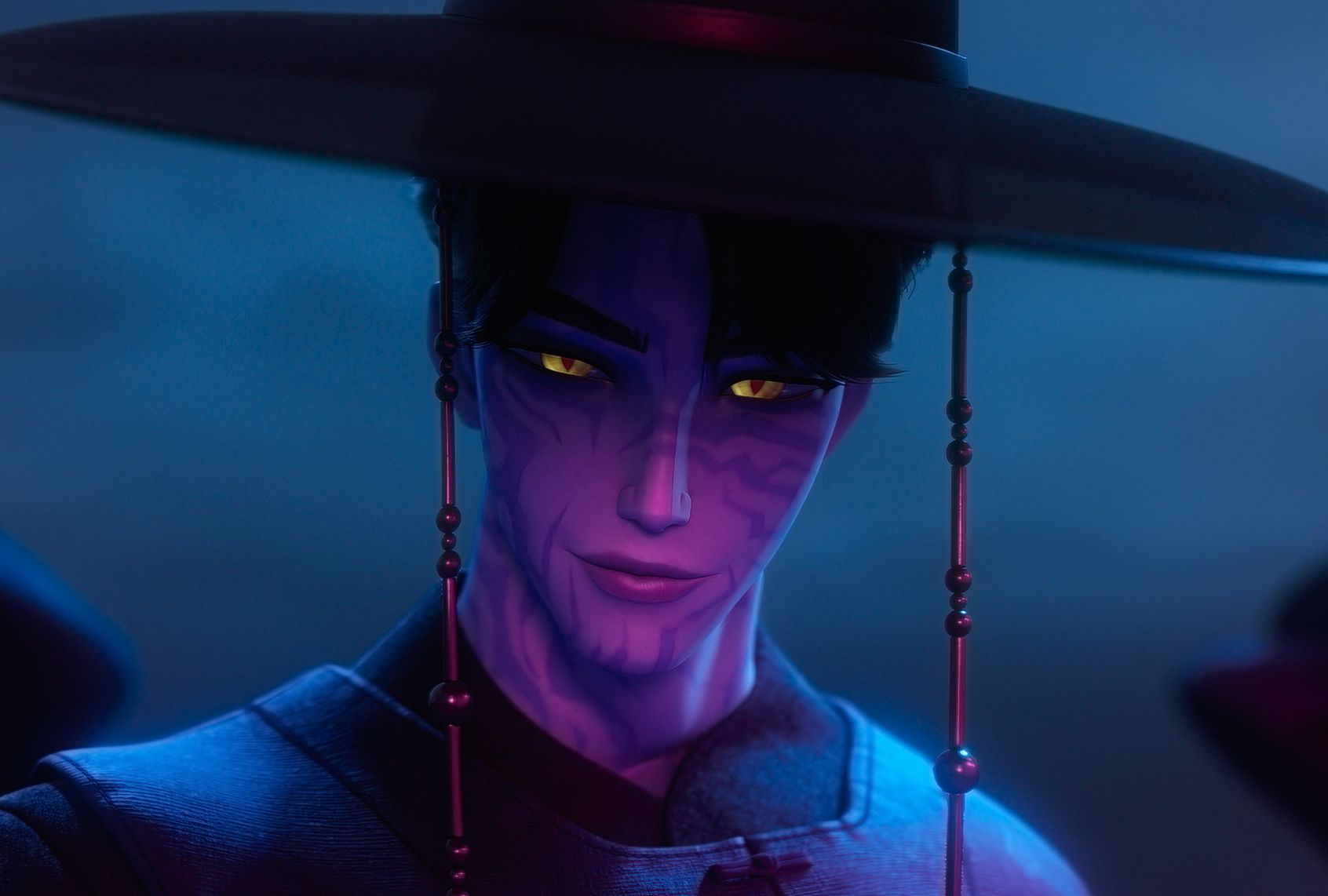Friendship bracelets. Must-have merch. Idol worship. Global fame. Loyal fans who will give up a piece of their soul for you. Long before Taylor Swift released her first single, K-pop captivated audiences to create a new level of fandom heretofore unknown. And with that came the criticism.
Netflix’s animated “KPop Demon Hunters” offers a window into the controversial culture of K-pop fandom via the supernatural. The movie has become a sensation, hitting No. 1 on streaming in more than 20 countries and for its original K-pop soundtrack ranking high on streaming charts. In the film, Korean folklore heroes and demons come to life as opposing K-pop groups: the noble girl group Huntr/x and the soul-sucking Saja Boys.The way that each approaches attracting and retaining fans hinges on the personal. Yes, a catchy song is important, but moreso are the personas and relationships built to make that lasting impression.
A battle for hearts and minds
The Saja Boys are loosely inspired by the Jeoseung saja, who in Korean folklore are psychopomps – with Jeoseung roughly translating to “afterworld” and saja meaning “messenger” or “emissary” – immortal beings ushering human souls to the afterlife, much like Charon the ferryman or the Grim Reaper. They’re often depicted in traditional black hanbok and tall gat hats, which explains the Saja Boys’ costuming later in the movie.
“The look of those boys in the Third Act reveal is based on the Jeoseung saja, the Grim Reaper Korean mythology,” Chris Appelhans, who co-wrote and co-directed the movie with Maggie Kang, told Salon. “Because there’s such a great tradition in K-pop of groups changing looks and always in ways that are fashionable and awesome-looking, we started there. We then got to match that up with a bunch of Givenchy costume designs . . . and basically bring a fantastic K-pop aesthetic with that historical theme.”
In “KPop Demon Hunters,” however, these demons are not waiting passively for humans to die but are rather preemptively harvesting souls through their addictive tunes and undeniable physical magnetism. They keep up a constant barrage of social media posts, and variety show and surprise appearances. If charming seduction could dance, it would be the Saja Boys. One could interpret the Saja Boys as an indictment of the K-pop industry’s capitalist drive. This is a business after all, and selling tickets, albums, sponsorships, interactive fan experiences and merch – both for the band overall and for a fan’s “bias” or favorite band member – are the goal.
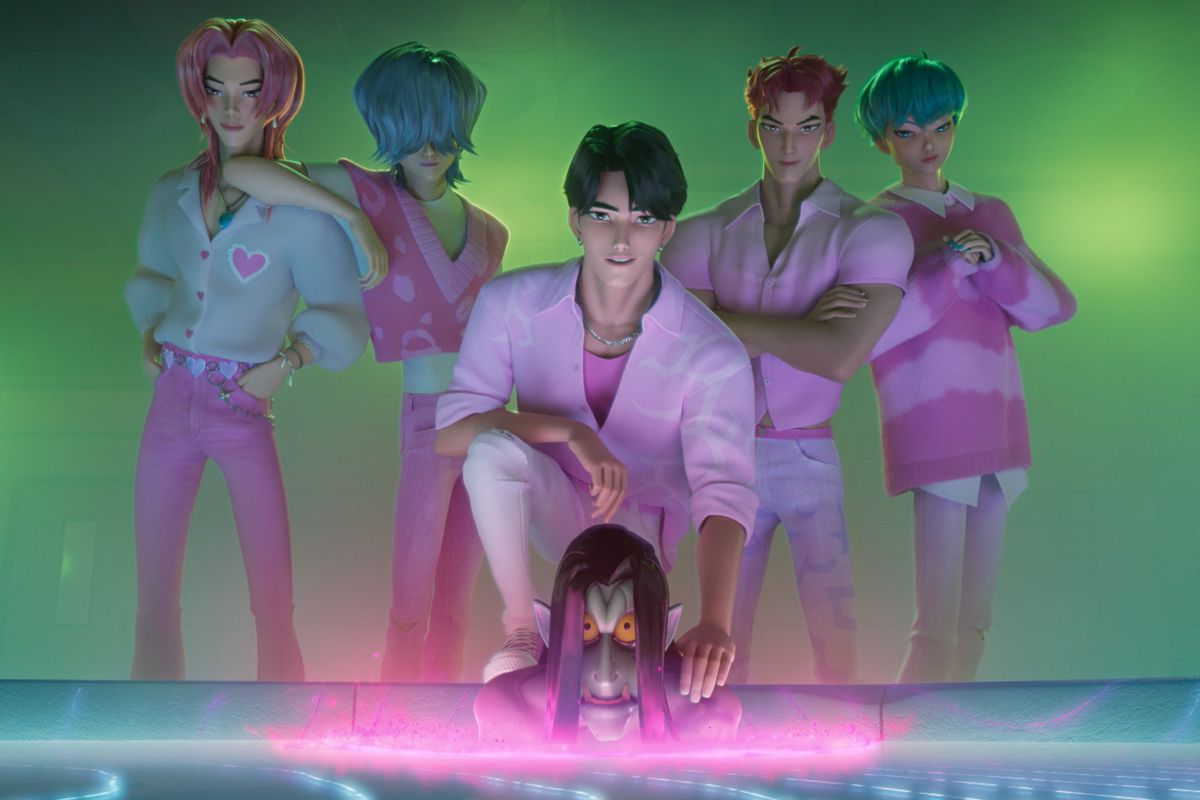
(Netflix) “Kpop Demon Hunters”: The Saja Boys in a Korean spa with a demon
Shelling out hundreds if not thousands of dollars a year is seen as an adequate trade-off for what the fan receives in return: an intense parasocial relationship. The idols’ side of this contract is to actively present a reciprocal affection and appreciation through fan service. The band members find every opportunity to engage with their followers, from recording extra content to interacting with fans in person. In fact, it’s the band that bestows the fandom name – ARMY for BTS, Stay for Stray Kids, etc. – upon their devotees. In the case of this movie, saja also means “lion” in Korean, hence the lion symbolizing the Saja Boys and dubbing their fandom the Pride.
“That was one of the most important things that we wanted to showcase in the movie – the fan and idol relationship because that relationship really is so special,” said Kang. “It doesn’t really exist in any other sectors of entertainment, so idols are always providing a lot of content and giving to the fans, and then they receive love back from the fans.
“I went to a Stray Kids concert, and it’s just amazing how much fan service they do. They’re crying on stage and you know that that’s real, and the fans are crying, and it’s just a huge cry fest and it’s so beautiful. That itself is an energy, a kinetic energy that you can feel when you’re in those concerts.”
On the surface the Saja Boys appear to be appreciative of their fans, but a closer read of the lyrics in the song “Your Idol” reveals this is where they fall short.
Keeping you in check, keeping you obsessed,
Play me on repeat, endlessly in your head.
Anytime it hurts, play another verse,
I can be your sanctuary.
Know I’m the only one right now.
I will love you more when it all burns down,
More than power, more than gold.
Yeah, you gave me your heart, now I’m hеre for your soul.. . .
Your obsession feeds our connection.
So right now give me all your attention.
“It’s often said that music is the language of the soul, and so it does feel very fitting that if you can tap into someone’s emotions with music, you can pretty much do anything,” said Kang. “We see that with the Saja Boys too. They are tempting you into the underworld with their evilness. If you look at the Saja Boys’ song, the lyrics are all about taking, and me consuming you, and you coming to me. That was purposely done because we wanted the songs to feel pretty shallow, really. The artist wasn’t giving anything; they were just taking.”
Therefore, the Saja Boys’ greatest sin isn’t that they want to steal souls or make money; it’s that they are not giving back to the fans. It’s the ultimate betrayal: twisting the language of k-pop to hurt their fandom.
The sincere shamans
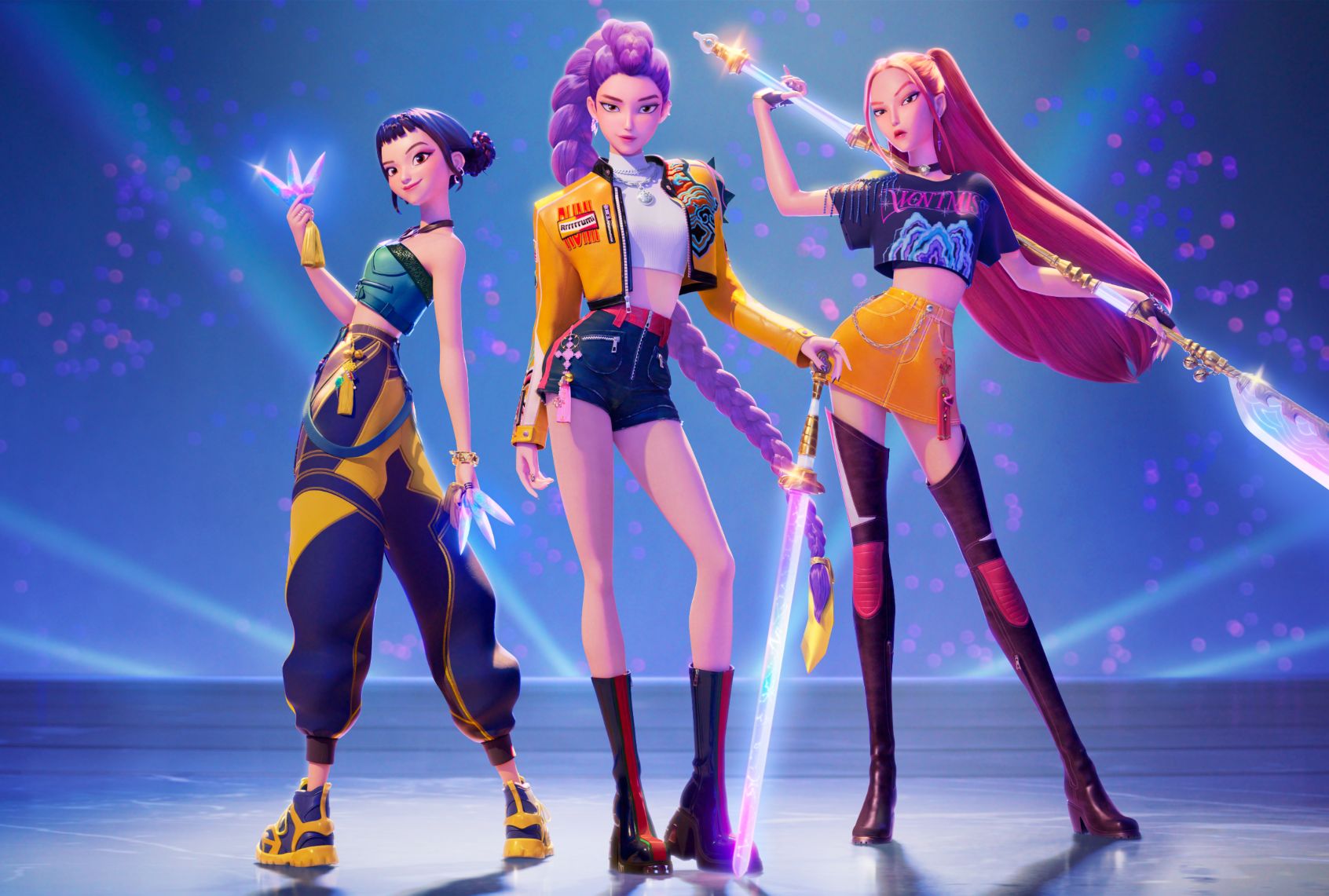
(Netflix) “Kpop Demon Hunters”: Huntr/x shows off their weapons
Opposing the Saja Boys is the movie’s equivalent of Buffy the Vampire Slayer, but in triplicate. Huntrix (styled Huntr/x) is a trio of female singers – Rumi, Mira and Zoey – who are also demon hunters, carrying on a tradition of singer-fighters in every generation. And it’s no accident that they’re all women.
“With the mythology, we wanted to root it in something that existed in Korean culture already. What it is, is Korean Shamanism,” said Kang. “Historically, Korean shamans are mostly women, which was kind of perfect for us. They were women, but they actually wore male garb, so they were dressed looking like men.”
The shamans, like the one seen in “Squid Game,” usually are mediators to the spirit world using divination or other rituals. For the purposes of this movie, however, the hunters have songs and martial arts in their arsenal, with each of the members wielding a weapon that fits their personality or style.
“[Rumi] felt like she was the most gung-ho about killing demons, so it felt like a big, blunt sword that she could just swing around and create as much chaos with would be the best thing,” explained Kang. “With Mira, she’s just long and lean, so we went with – it’s called a woldo, the big long pole with the blade at the end, so that she could swing it around and make very long shapes. That’s just kind of her thing. With Zoey being the rapper and dancer and her personality is very poppy, we thought that daggers that she could just throw to the beat would be really good for her.”
Through their physical prowess, Huntrix can kill demons. Through song and their effect on fans’ souls, Huntrix can also create a supernatural barrier – called the Honmoon – to keep the demons at bay. The group’s goal is to increase the power of this barrier to create the Golden Honmoon, which will keep the demons out of the human world for good. This is why the successful release of their new song “Golden” is essential.
Unfortunately for Rumi, the lead singer of Huntr/x, her usually powerful voice keeps failing her, and this is tied to the secret she’s hiding of being half-human, half-demon. Her mixed heritage makes itself known through bright patterns on her skin, which she usually keeps covered up, and now through her voice breaking.
In the world of K-pop, seeing idols making mistakes, being overcome with emotion, or joking around with each other is part of the fan service that strengthens the parasocial relationship. Fans want to see the humanity in their favorites, which is why the key to Rumi unlocking her voice and song, defeating the Saja Boys and unleashing the Golden Honmoon hinges on her accepting and showing all aspects of her identity.
This culminates in Rumi and the rest of Huntr/x eclipsing the Saja Boys by singing “What It Sounds Like,” an anthem to self-acceptance:
Here’s a sample of the lyrics, which alludes to the scars, aka the patterns, on Rumi’s skin.
I broke into a million pieces, and I can’t go back
But now I’m seeing all the beauty in the broken glass
The scars are part of me, darkness and harmony
My voice without the lies, this is what it sounds like
Why did I cover up the colors stuck inside my head?
I should’ve let the jagged edges meet the light instead
Show me what’s underneath, I’ll find your harmony
The song we couldn’t write, this is what it sounds like
Rumi is named after Kang’s daughter with storyboard artist/character designer Radford Sechrist, creator of Netflix’s acclaimed series “Kipo and the Age of Wonderbeasts.” This real-life daughter also provided the voice for young Rumi in the movie.
“With Rumi’s story, when we were crafting it, we talked a lot about mixed heritage,” said Kang. “We also talked about queer community and just a queer identity, and addiction and falling back into addiction. We kind of described the demon part of you as that. That is what somebody would see it as, the part that they’re hiding from the world. It’s cool to hear that so many people are resonating with the song and the message of the movie and Rumi’s journey with the song.
“We had a version of the song [that] was called ‘Kaleidoscope.’ It was like taking all the pieces of yourself and making it beautiful. That’s where the song had started, and from there, we still kept the lyrics of broken pieces and finding yourself within those broken pieces.”
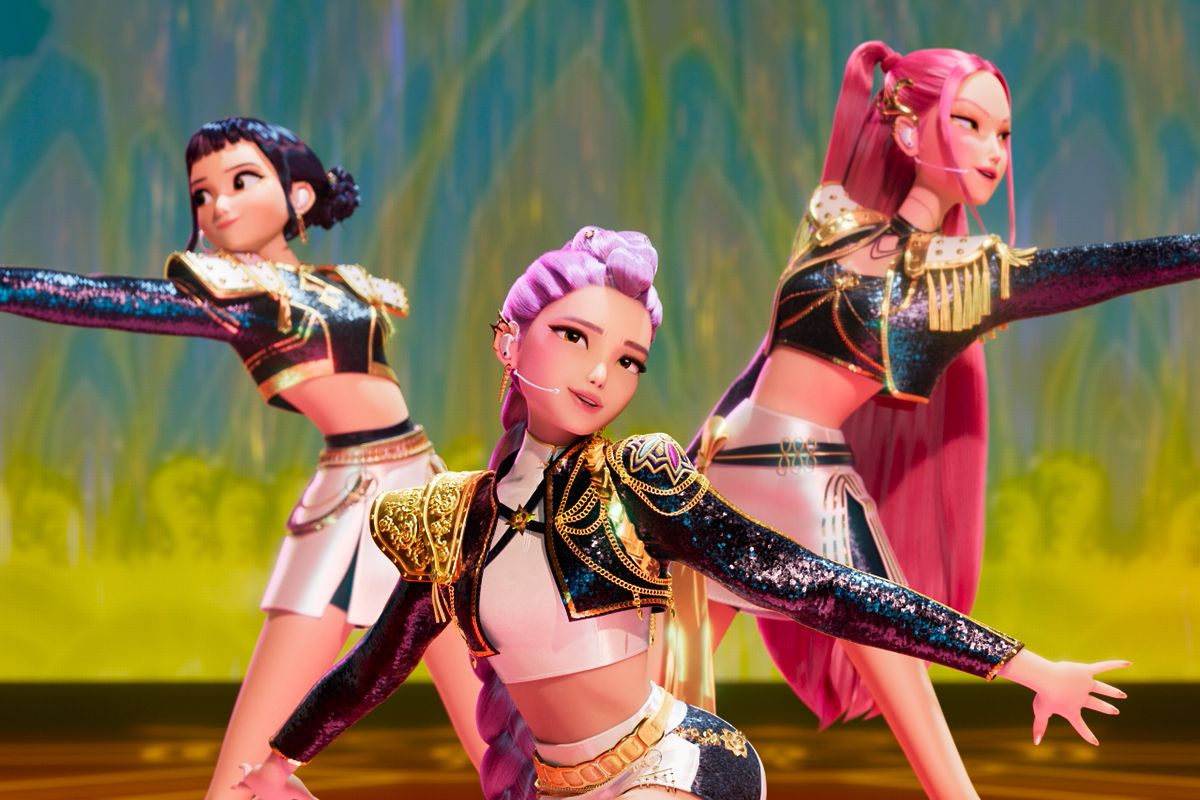
(Netflix) “Kpop Demon Hunters” Huntr/x members Zoey, Rumi and Mira execute flawless choreo
Appelhans noted that earlier versions of the song didn’t ring true because the narrative was wrapped up too neatly. Songwriters Stephen Kirk and Jenna Andrews (who had worked on BTS’ “Butter”) found inspiration in another song that is about accepting hurt and trouble in order to learn and move on.
“A great reference for us was ‘Green Light’ by Lorde, because that was about heartbreak that you’re trying to get past,” said Appelhans. “You get that green light that you will be stronger from having been through this pain and having had this relationship. When’s that green light coming? Can I get it? So all those things really helped us push the song in a direction that wasn’t nearly as tidy. When the song is also the climax of your movie, it needs to have tension. It needs to feel like, ‘Is this going to resolve? Are we going to find an answer?'”
This brings us back to the parasocial relationship feedback loop, whereby an idol exposing parts of themselves is seen as an act of sincerity to the fans, who then give even more love back in return.
Kang added, “In the songwriting, we really concentrated on the last song being like ‘This is the song we couldn’t write,’ because they weren’t in that emotional place to be giving [yet]. In the last song, the lyrics are all about giving and giving to each other and giving to the world, and in turn, getting everything back . . .
“You know that feeling that you get at a concert when you’re with other people listening to this music and you turn to someone next to you and you don’t even know who they are and you’re just like, ‘Yeah!’ You know that feeling? We really wanted to treat it as this superpower and super magical thing. Bringing the crowd in at the very end to really give Rumi that boost, to really seal the deal on [demon master] Gwi-Ma, was all laid out through the concept.”
The visuals
In K-pop, the “visual” is a term referring to one member of the group who best represents the beauty ideals of South Korea. In Huntr/x, Mira is considered the visual. Take a look:
From an outsider’s perspective, however, one person representing the visual may be difficult to grasp since all of the members of a K-pop group these days tend to be objectively attractive. Switching one’s bias is a common occurrence among diehard fans who are consistently discovering new charms among the members.
While attractiveness is a superficial aspect of K-pop, it is nevertheless an essential part, and the team behind “KPop Demon Hunters” approached each group’s looks strategically. For Huntr/x, making each member distinct in appearance and personality emphasizes their individuality as heroes worth identifying with.
“On Rumi, the big purple braid was designed nine years ago when the character was first designed for a different project that my husband was creating,” said Kang. “I liked the character so much. I was like, ‘Can I just steal her?’ and I just plopped her into ‘KPop.’ It was a nod to traditional Korean hair. There’s a lot of braiding that we use, so just to modernize it, we made it this really thick braid that started from the top of her head, hitting that iconic anime style by making it unrealistically long so she could just swing it and follow through in battle.
“With Mira, we wanted to give one of the members really long flowy hair, and it was the most complex hair that we had to work with in the movie. With Zoey, her buns are actually braided as well, so that was another braided element that we added, just to give her that traditional look.”
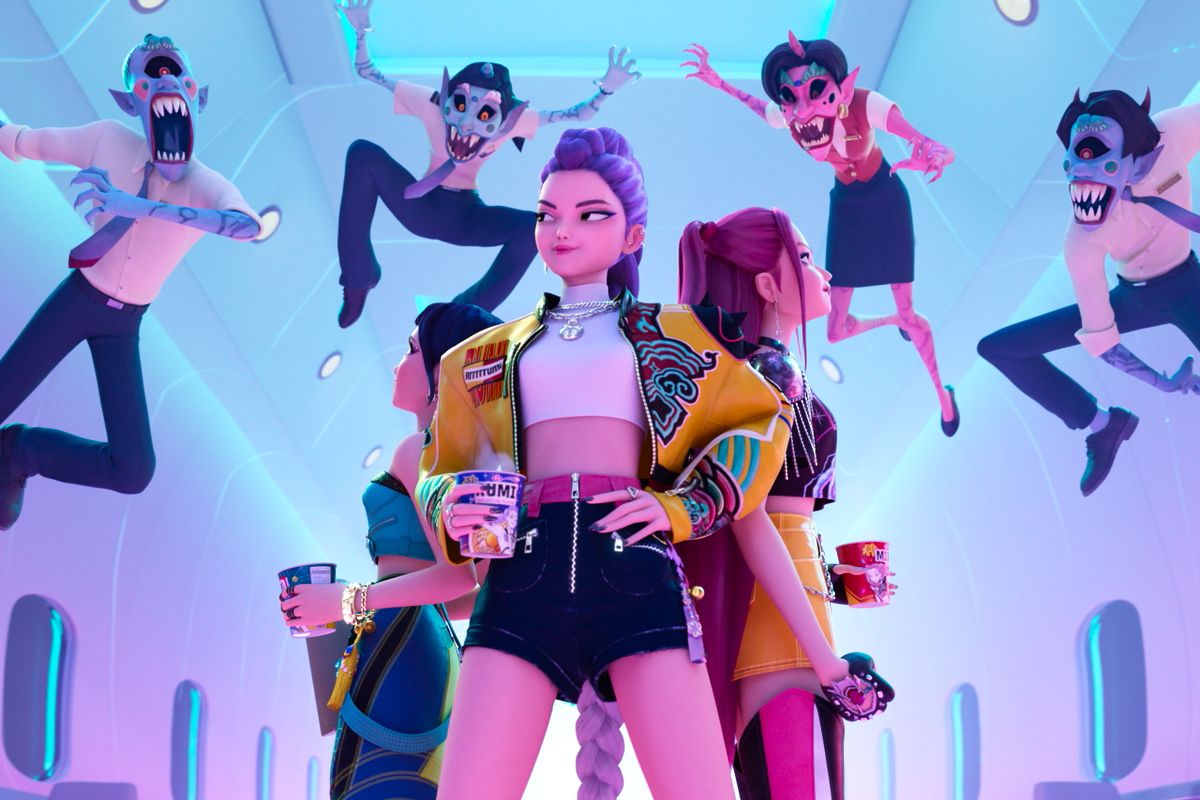
(Netflix) “Kpop Demon Hunters”: Huntr/x members’ ramyeon time rudely interrupted by demon flight attendants.
Making each character look Korean also meant that animators studied numerous real Korean faces to diversify the shape of the faces and eyes, yet still portray them accurately.
“For their faces, we didn’t want the girls to be identified with just their hairstyles, so we worked really hard to find design elements and design them in a different way,” said Kang. “Mira, she’s very long and lean and has more narrow eyes. Rumi, we leaned into a very classic Korean look. Zoey, we gave her a little more of a heart-shaped mouth, and we gave her some freckles and a little bigger, rounder, doe-ier eyes.
“If you look at their body types as well, Zoey is a little shorter, and her calves are a little thicker, so she has a little bit more weight on her. We just wanted all the girls to have a distinct look but still feel Asian and beautiful and Korean.”
If authenticity is the mark of the heroes, the commerce is what drives the villains. The K-pop industry is known for heavy management involvement in churning out idols through a rigorous trainee system in a calculated, commercial endeavor. Perhaps that’s why the Saja Boys – except for the super-buff Abby – were designed to have all the same body but with different faces and trappings. They were evilly engineered for thirst.
Jinu is the lead vocalist and visual of the group, and his looks were created from an amalgam of classic k-drama lead actors, including Cha Eun-woo, Nam Joo-hyuk and even Ahn Hyo-seop, the star of “Business Proposal” who also provides the speaking voice of Jinu. It should be noted that only Jinu has a real name, whereas the rest of the band members have names that are more descriptive of K-pop archetypes: Abby has the abs, Romance is a ladies’ man, Mystery is inscrutable and has hair covering his eyes, and Baby is the cute rapper who’s also the maknae (youngest member).
“Abby is probably my bias. I have never revealed that, but yes. I just think he is so hot,” admitted Kang. “I don’t know. He’s got these weird eyebrows that were jet black, and we made them different and we were like, ‘It’s no longer him.’ We kept calling him Abs Saja, but it felt like, when the boys are on the variety show and they have their names written on the bibs, he needed a name. So it felt like Ab to Abby was a very cute jump. So that’s how he’s named.
“With Romance, we just leaned in. He was kind of like our Fabio, and what’s hilarious is the artist that designed the Saja Boys, Marion Bordeyne, she’s a very young, very fashionable French lady, and the direction she got was, ‘We want him to look like Fabio.’ She did the designs and presented them, and she said, ‘By the way, I have no idea what a Fabio is.’ We just leaned into the motif of hearts, so everything about him is heart-shaped. He’s throwing hearts, and we wanted to design his bangs more heart-shaped.
“And Mystery, that’s a mystery to me. I think we wanted one of the members to be a mysterious kind of guy where he’s very opaque, and you didn’t know what he was thinking. So just to cover his face with his hair suited that, but also helped us tremendously with animation because it was another face that we didn’t have to animate.
“Baby, obviously he’s the maknae, the baby of the group. Chris has always found Baby to be so cringe. Anytime we’d do reviews of anything Baby, he’s like ‘Stupid face! Ugh!’ And then when we saw all of that animation, Chris just sat there like, ‘Ugh! Why is he so hot?'”
Applehans added, “We were constantly harping [that] whatever we do to push these guys, they have to still always pass the hot test. And I remember late in production, I saw a shot at the end of the movie of Baby Saja rapping and I was like, ‘Oh no, finally, he’s incredibly hot to me.'”
Check out Marion Bordeyne’s Saja Boys design concepts:
A gateway of connection
Huntr/x’s success with the fans is all down to showing vulnerability and forging a connection. Similarly, the outsized response to “KPop Demon Hunters” reflects having a similar resonance with viewers. While a sequel has not been announced yet, the filmmakers acknowledged that there was plenty more story to tell, and in fact, some of it ended up on the cutting room floor.
Appelhans said, “In the fan and audience reactions and discourse, the kind of precision with which people understood what was going on inside characters’ heads and then the curiosity that that made for everything that wasn’t revealed in the movie is really awesome. You wonder sometimes, like, is this backstory, is this subtext coming through? And then people basically write out of their own head the same bio that you had written for the character years ago.
“The characters do have a lot of depth. We thought a lot about them and a lot about the world and the mythology, and 85 minutes is very little time to get all that. We realized that as we were getting deeper in, we have more here than we could probably ever fit in 85 minutes, so let’s fit Rumi’s story as best we can.”
This focus on Rumi’s central story unfortunately meant that questions about her bandmates and even their mentor Celine were left unanswered.
“We thought of all of it, and even had backstories for Mira and Zoey,” said Kang. “We have actual storyboards that we created and had, at one point, put into the cut, of the girls coming together and meeting for the first time and training with Celine. It didn’t fit into the movie. At a certain point, the movie starts to tell you what it wants to be, and it just rejected it. It was like, ‘This is not the movie that I am.’ So we had to make really harsh decisions about what was shown in this movie, and if it didn’t serve the main story, which was Rumi’s journey, then we had to omit it.
“So we found other ways to kind of sneak it in there,” she continued. “The song ‘Golden’ is where we get a bit of Mira and Zoey’s backstory that helps us understand them through their journey, and that felt like it was enough for this movie. There is a lot of thought and writing and even storyboards and ideas that are on the cutting room floor that can definitely feed another [piece of] content, whatever that is. But for this story, we had to be very strict because it’s very small time. And even within this movie, there was so much that we had to cram in.”
Of course, no matter how strong the parasocial relationship, the fans wouldn’t be as invested if they didn’t also find the music appealing. And “KPop Demon Hunters” delivers banger after banger of original K-pop hits – produced by K-pop heavyweights who’ve worked with the likes of Blackpink, BTS, Twice and more. The soundtrack may be full of songs by fictional animated pop groups, but they’ve made a mark on real album charts.
While Huntr/x may have wanted to find just the right song to create the Golden Honmoon, which loosely translated means “soul door” or “soul entry,” it looks like they already did in the real world. The film’s songs have become a gateway to the movie, and then to K-pop itself for those unfamiliar with the genre. I’ve even added some of Huntr/x’s songs to my resistance playlist titled, “Them’s Fighting Words.”
“We really saw it have this trickle effect of, like, I feel like people are finding the music and then going to watch the film as well,” said Kang. “That’s what K-pop, as a genre of music, has taught us – that it doesn’t matter what language the song is in. It doesn’t matter what nationality, what culture the singers are; you are just kind of vibing with the music. You’re emotionally connected to something so musically that you’re just drawn to it, and you don’t really have to understand the lyrics in order to feel something.
“It’s really interesting and fun to see the message of the movie do its thing in real life with the release. In that way, it has just kind of naturally become meaningful for everybody. I think whatever song becomes the song of the summer will always just naturally become a resistance song because it’s just the mentality that everybody is in currently. Anything that can fuel connection and a sense of unity and hope for everybody, we’re just excited for any of our songs to contribute to that.”
“KPop Demon Hunters” is now streaming on Netflix.
Read more
about this topic
